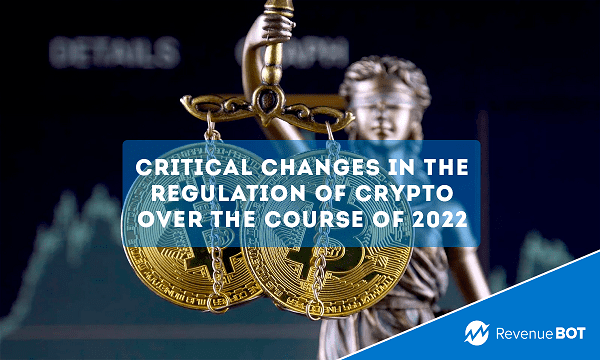
We have had a year fraught with unpleasant surprises. This includes the crypto industry as well. The value of the first-ever cryptocurrency, a Bitcoin, collapsed drastically, almost threefold. As a consequence of this drop, a series of bankruptcies of large companies began, followed by layoffs.
On top of that, one of the top exchanges FTX went bankrupt, the Ripple case and the SEC and so on. Nevertheless, 2022 marks the year when a series of global regulations on digital assets, that’s whu it will also be remembered. At first glance, it may seem that such regulations do nothing but harm the crypto industry, something that is not completely true, since the impact of the new bills could work to the industry’s advantage in the long run.

We will take a look at the most significant regulatory events that took place last year in this article and see how they may affect the crypto community in the years to come.
MiCA restricts European crypto companies with its hard cap and euro peg
MiCA is expected to come into effect in 2024. According to the proposed new law, only assets that are pegged to the euro and completely backed 1:1 are permitted, basically making algorithmic stablecoins and those pegged to anything else illegal.
Furthermore, the bill imposes a hard cap of 200 million euros worth of daily trading volume – a number much lower than most markets trade. It is here that MiCA restricts European crypto companies’ potential for both innovation and competition.
The EU claims MiCA will encourage adoption through regulation, yet more reliable digital assets such as stablecoins are restricted by the bill. Mathieu Hardy, from asset management app OSOM, feels there’s almost a tech-based discrimination when it comes to foreign currencies.
To say regulation will limit innovation is almost redundant now. But the pain point unique to MiCA is the way in which the bill actively shapes the crypto space in future. MiCA is supposedly written with the user in mind, but the wording and sheer amount of text focused around anti-money laundering (AML) rules is indicative of its true agenda. In terms of consumer protection, having a framework such as MiCA is great, but when consumer protection is achieved by making it so expensive to operate a crypto company in Europe that only well-established ones can do it, MiCA is hurting consumers in the long run.
USA and Canada
Another distressing event in the crypto industry to consider is the regulation that occurred in the U.S. and its neighboring country, Canada. The thing is that there are two places in both countries that are considered extremely lucrative in terms of mining – New York and Manitoba.

Last year, both of these places passed a moratorium on activities relating to the mining of digital assets. It has been reviewed for quite some time, since Proof-of-Work mechanism is an ecologically destructive option. Numerous eco-activists rallied for the authorities to ban mining completely. From now on, the Proof-of-Stake consensus mechanism is seen as a more appealing solution.
Notably, New York’s moratorium does not prohibit PoW mining at all, as long as it allows 100% renewable energy to be used as an exception. This further links the discussion to the debate around “renewable energy,” since miners and crypto proponents are making the case to capture the public mood. Although moratoriums have only been imposed in two small areas, the fierce battle between PoW and PoS sympathizers is nowhere near the end.
Crypto becomes a payment method in Brazil
By the end of the fall, the great news came from Brazil. The country’s MPs passed a regulatory framework suggesting that digital assets can now be used to pay for goods and services in Brazil. It is worth mentioning that digital assets have not yet established as legal tender in the country, like in El Salvador, yet it would get the ball rolling towards a comprehensive regulatory system.

This is certainly not such big news compared to reports of crypto regulation in the U.S. and Europe. However, we should keep in mind that such news still tends to be positive for digital assets in Latin America.
Conclusion
The new laws to regulate cryptocurrency have taken place almost all over the world, as seen in the article. The U.S., Canada, and Europe suffer stricter bills, while Latin America enjoys positive ones. In spite of all this, crypto proceeds its way to enter many industries; Web 3.0, NFT and other are also of high interest among the community.
